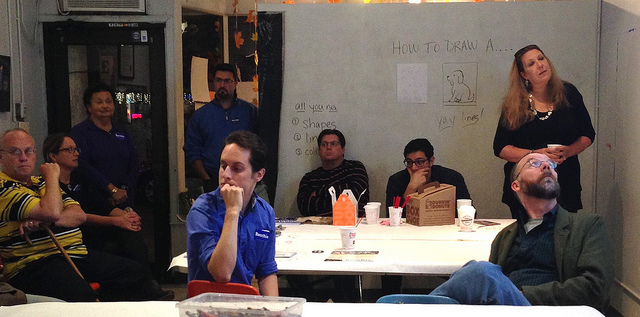Domenic Recchia for Congress volunteers listening to Get Out the Vote strategy at a Brooklyn staging location. Recchia, a Democrat is running for New York’s 11th Congressional District, representing south Brooklyn and Staten Island. Photo by Zehra Rehman
By Zehra Rehman
“I’m tired,” Elaine Kateb heard over the intercom before it went silent. Kateb, 70, then went back down the apartment building’s stairs. She and many other volunteers had spent that rainy day ringing doorbells in their neighborhoods to persuade people to vote for Domenic Recchia.
The race for New York’s 11th Congressional District seat has been one of the most competitive in the current election cycle, although the latest poll by NY1/Capital New York/Siena College shows Republican Michael Grimm leading 53-34.
Grimm won his seat in 2010 by defeating a Democratic incumbent. Democrat Recchia is running against him to represent Staten Island and part of south Brooklyn. Grimm has the advantage of incumbency but has been indicted on 20 federal charges including tax evasion and fraud. Democrats have looked at this as an opportunity to win back the only Republican congressional seat in New York City.
The Recchia campaign is based in two offices in Staten Island and one in south Brooklyn. The Democratic Party has been strongly backing Recchia including providing resources such as campaign staff and political ads. The campaign is made up of a paid staff along with hundreds of volunteers. This includes a core group of regular volunteers who have been essential for the Recchia campaign. Ranging in age from 10 to 85 years old, they are motivated by a combination of idealism and a desire to see the incumbent defeated.
The Recchia campaign has divided its activities into three stages. The first phase, which ended on Oct. 10, was voter registration. The second stage is canvassing and persuading voters to choose Recchia. The last stage, from Nov. 1 to 4, is Get Out the Vote, during which the campaign will make about one-third of its total voter contact. The GOTV efforts will be launched from staging locations in Staten Island and Brooklyn. In these last four days, the campaign will receive volunteers from across the country including students, union members and congressional staffers. Until then, the campaign staff and their team of volunteers do all the work.
Daren Dowlat describes himself as “a volunteer who came in and never left.” He makes phone calls to get more volunteers, goes door to door to give voters information and carried out voter registration. Dowlat started volunteering while looking for a job in the information technology field. After working on the campaign, he is considering a change in career direction to “try to clean up politics.”
Because of a disability, 81-year-old Phyllis Masci is not able to go door to door. She comes to the campaign’s Brooklyn office three days a week to work the phone bank and recruit more volunteers. The rest of the week she makes phone calls from home. Her reasons for volunteering are a dislike of the incumbent and a belief that Recchia will be a good representative of her district in Washington.
“I know he will do a lot for the community. I know he will!” she emphasized.
Volunteer Pat Sanchez has been working on campaigns for decades, starting with fundraising for Bill Clinton’s presidential campaign. A staunch liberal from Bay Ridge, she wants “to get this neighborhood blue.” She was surprised that Grimm remained popular in Staten Island after a video surfaced of him threatening a reporter. A recent opinion poll also showed that 24 percent of Staten Island voters are less likely to vote for Recchia because he lives in Brooklyn. The majority of the voters in the district live in Staten Island, where Grimm lives.
With the race drawing increasing attention, volunteers are arriving from outside New York and even one from another continent. Quentin Lefevre came from Paris to volunteer for the Recchia campaign. “I love the things that he wanted to implement in New York,” he said of Recchia. Lefevre also hopes to learn from this campaign and apply the experience to French political campaigns.
With a contact rate of less than 10 percent, door-to-door canvassing is a tedious part of campaigning, and one where volunteers are most needed. “Canvassing is becoming more important. Usually it doesn’t change minds but it turns out votes,” said Steven Brams, professor of politics at New York University. As part of the canvassing, campaign staff and volunteers try to persuade potential voters to sign pledge cards, which increase voter turnout by 6 to 8 percent.
After weeks of making phone calls for the campaign, Kateb went door-to-door for the first time on Oct. 11. Even when she made contact with voters, many refused to talk. While joking about “being too old for this” and it being “as much fun as a root canal,” she rang doorbells across Bay Ridge. She volunteers for Recchia because she wants to “work with candidates in whom I believe” and because Grimm is facing criminal charges. Above all, she feels a civic duty to participate in the political process, pointing out that “people in other countries would die for the opportunity to vote.”
With days left until the Nov. 4 election, campaign staff and volunteers are putting all their energy into getting their candidate elected.
